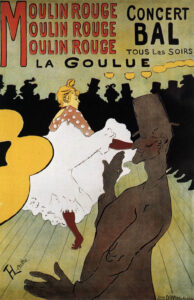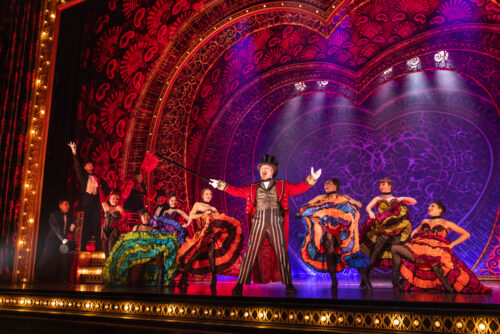Moulin Rouge! The Musical
Ten years ago I saw Moulin Rouge! for the first time on my friend’s laptop in our college dorm. I enjoyed the film, and when it was announced that the Broadway adaptation was making its way to TPAC, I got excited. While I didn’t remember many details of the plot, I remembered spectacle, music, and a satisfying mixture of comedy and melodrama. The Broadway show doesn’t disappoint.

For those unfamiliar with Baz Luhrmann’s film, it’s a 2001 jukebox musical set in Paris at the turn of the 20th century. The Moulin Rouge is a real cabaret (you can visit it today) and the birthplace of the can-can dance. It was in a poor district where wealthy aristocrats could play at slumming it and mix with the bohemian locals. One such local artist was the famous painter Henri de Toulouse-Lautrec, who designed posters for the venue, and who features as a character in the story.
The plot is simple: Satine is a courtesan who is the star performer at the financially struggling Moulin Rouge. Christian is new to Paris and hoping to make it as an artist. He quickly falls in with Toulouse-Lautrec and they work on a musical show to pitch to Satine, hoping to get it on the stage of the cabaret. Satine is told by Zidler, the founder of the cabaret, that after her performance that night she is to entertain the Duke of Monroth in her chambers upstairs, and that the great hope is to convince the wealthy aristocrat to provide financial backing to prevent the club from going under. In a fateful miscommunication, Satine thinks that Christian is the duke, and invites him upstairs after the show. In a hilarious scene she tries to seduce him while he’s trying to pitch the musical, and as they’re getting to know each other the real duke shows up at her door. Realizing the mixup, Satine covers for Christian’s presence by pitching the musical to the real duke, and convinces him to back the show. As the story progresses, Satine has to figure out what she wants, choosing between the poor but kind Christian and the selfish Duke who stands as the stereotype of her material ambition.
The Broadway musical has surprisingly little dialogue and is crammed absolutely full of music. The medleys are almost nonstop: pages 28-30 of the program are tightly packed musical credits listing the musical quotes. The music of the film has been updated, altering some of the major moments and adding to many of the minor ones with hits like “All the Single Ladies,” “Rolling in the Deep,” “Bad Romance,” “Chandelier,” and (delightfully) “Fidelity” and “Royals.” This is only naming a few of the recent updates (which even include a Rickroll). Each possible line of dialogue is used to break into song, musical quotes continually riffing off of each other. The frenetic pop music is fun but by the end of the night I felt over-stimulated in a way that even Broadway’s Beetlejuice hadn’t left me. My experience of the music reminded me of the first 55 seconds of this clip from Dead Men Don’t Wear Plaid: STEVE MARTIN MAKES COFFEE. I went through phases of being entertained, finding it too much, and being entertained again. My only real musical disappointments in the updated arrangements were that “Roxanne,” the dramatic song of angst, was adapted in a way that felt less impactful than that of the film, and that “Firework” was used for Satine to express her inner conflict; I was tired of that song back in 2010.

The film is set in a cabaret that was the epitome of fin-de-siècle European decadence, and it won an Oscar for its costume design. Not to be outdone, the Broadway adaptation won ten Tony awards, four of which are for costumes, stage, choreography, and lighting design, all of which are fantastic and attention-grabbing. The opening of the musical showcases all of this at once, as we witness the Moulin Rouge’s spectacle: massive setpieces of opulent splendor have lingerie-clad dancers performing high energy sensual movements, while the lighting uses spotlights, silhouettes, and dramatic colors to set everything off. The imagination and skill in accomplishing the intended effect is very impressive.
Moulin Rouge’s cast is somewhat uneven: some actors are surprisingly pitchy or sound like they have been cast for the wrong vocal range, but the standouts are amazing. Christian Douglas plays Christian, and his voice is fantastic: strong, clear, and always in perfect control. While his character isn’t particularly interesting, he gives the role as much personality as possible. Robert Petkoff is the reprobate Zidler, and his dramatic showmanship, heart, and humor make him the most enjoyable character to watch. AK Naderer is Nini, Satine’s friend, and one of the dancers. No matter how crowded the stage, no matter what the choreography was, she always drew our eyes.

I attended the October 9th show. TPAC’s Jackson Theater was packed with people and looked to be almost entirely sold out. Everyone around us was excited for the show and remained fully invested the entire time. They responded to all the musical quotes, laughed at all the jokes, and when a character died at the end the hall was full of sniffles and stifled tears.
The show is full of lights and colors, nonstop music and activity and dancing, and the experience is a lot of fun. I’d recommend it to anyone who enjoyed the movie and to anyone who’s never heard of it: there’s no better setting for a story about live theater than on a Broadway stage.
Moulin Rouge! will be at TPAC until October 20, before moving on to Chattanooga. For tickets and more information, see Moulin Rouge! | TPAC and for more information about the national tour, see US Tour – Home – Moulin Rouge! The Musical.



